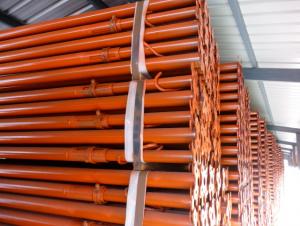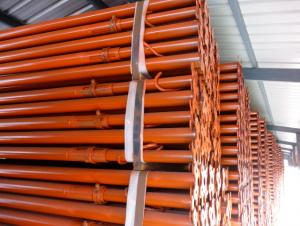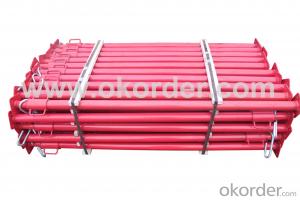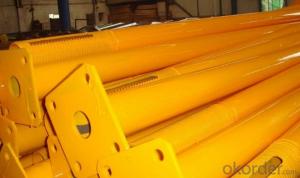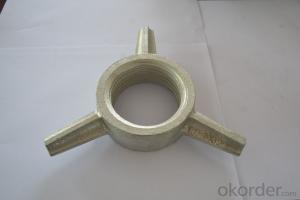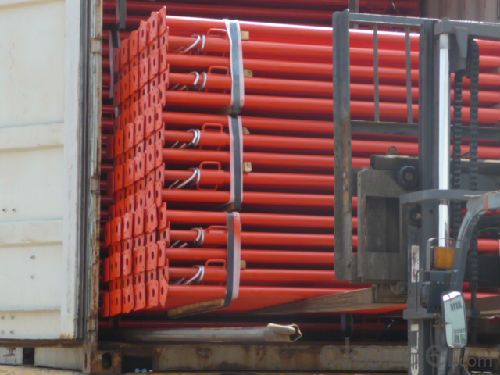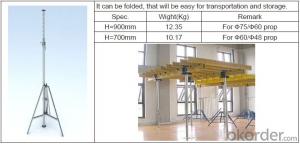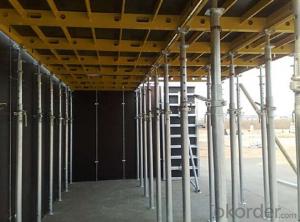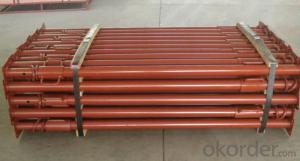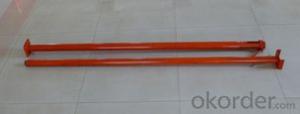Frame Scaffolding System, Movable Scaffold ,H frame Scaffolding
- Loading Port:
- China Main Port
- Payment Terms:
- TT or LC
- Min Order Qty:
- 1000 Set/Sets pc
- Supply Capability:
- 10000 pc/month
OKorder Service Pledge
OKorder Financial Service
You Might Also Like
Quick Details
Place of Origin: China (Mainland)
- Model Number: SD1700/1930CGSP
Place of Origin: China (Mainland)
Type: Scaffolding Parts
Scaffolding Part Type: Scaffolding Props
Color: 25/42
Coated: Painted;Pre-Galvanized; Electro Galvanized
Material grade: Q195-Q235
Package: Bundles or in Bulk
Certification: ISO9001:2008
Packaging & Delivery
| Packaging Details: | 1- Frame scaffolding system is packed in bundle and wrapped with iron bar . 2- Usually , one 40HQ container can load 300-600 set of props , |
|---|---|
| Delivery Detail: | 40days |
Specifications
Frame scaffolding system is easy to assemble and dismantle which can help to save your time , energy and cost .
Product Description
movable scaffold
A- An adjustable steel prop including inner tube, Outer tube , prop nut ,prop pin , base plate and top plate
B- Adjustable steel prop can be adjusted to any length within its range which is convenient for using
C- Adjustable steel prop is easy to assemble and dismantle which can help to save your time , energy and cost .
D-We have several kinds of adjustable steel prop which are Middle East type adjustable steel prop , Spanish adjustable steel prop ,and Italian type adjustable steel prop . They are popular in Africa , South America , Middle east etc.
E-Adjustable steel prop is for supporting concrete slab , beam , timber and formwork which is strong and reliable for interior building construction .
F- we can weld the flat plate or the flower plate, or U-head plate , or fork plate at the top of the adjustable steel prop as your request .
movable scaffold
- Q:How is a steel prop used in construction?
- A steel prop, also known as an adjustable steel prop or adjustable steel shore, is a tool commonly used in construction to support temporary structures or provide temporary support to existing structures during construction or renovation activities. Steel props are typically made of high-quality steel and are telescopic in nature, meaning they can be adjusted to various lengths as per the specific requirements of the construction project. They consist of an outer tube with multiple holes and an inner tube that fits inside the outer tube, allowing for height adjustments. The primary purpose of a steel prop is to provide vertical support, stability, and load-bearing capacity. They are often used to support horizontal beams, ceilings, slabs, formwork, and other temporary structures. Steel props can be used in a variety of construction scenarios, including residential, commercial, and industrial projects. The process of using a steel prop involves placing the prop vertically underneath the structure that requires support. The height of the prop is then adjusted by extending or retracting the inner tube and securing it in place using a locking mechanism or a pin. This allows the prop to bear the weight of the structure and provide the necessary support. Steel props are designed to withstand heavy loads and provide stability, making them a reliable choice in construction projects where temporary support is required. They are known for their durability, versatility, and ease of use. Additionally, their adjustable nature allows for flexibility in adapting to different heights, making them suitable for a wide range of applications. In conclusion, a steel prop is a crucial tool in construction, providing temporary support and stability to structures during construction or renovation activities. Its adjustable design and load-bearing capacity make it an essential component in various construction projects, ensuring safety and efficiency throughout the construction process.
- Q:Are steel props adjustable? If so, how?
- Steel props, also referred to as adjustable steel props or steel acrow props, possess the capability to be adjusted according to different construction needs. These props are commonly utilized in the construction industry to offer temporary support to walls, ceilings, beams, and other structural components. The primary advantage of steel props lies in their ability to be modified. This adjustability allows them to be set at varying heights, catering to diverse construction requirements. Typically, the adjustment mechanism of steel props comprises an outer tube and an inner tube. The outer tube is usually larger and features multiple holes at regular intervals. The inner tube, which fits inside the outer tube, possesses a pin that can be inserted into one of the holes in the outer tube to secure the desired height. To adjust a steel prop, the initial step involves loosening the locking mechanism, typically a pin or a collar responsible for holding the inner tube in place. Once the locking mechanism is loosened, the inner tube can be extended or retracted to attain the desired height. After adjusting the height, the inner tube is secured by inserting the pin into the appropriate hole in the outer tube. Subsequently, the locking mechanism is tightened to ensure stability. The versatility of steel props stems from their adjustability, rendering them suitable for a wide range of construction applications. These props can support varying load capacities, and their adjustable nature facilitates quick and effortless installation, as well as modifications throughout the construction process.
- Q:What is the maximum spacing between steel props?
- The maximum spacing between steel props depends on various factors such as the load capacity of the props, the height and width of the structure being supported, and the specific requirements of the construction project. However, as a general guideline, the maximum spacing between steel props is typically determined by engineering calculations and recommendations provided by the manufacturer or relevant industry standards. The purpose of steel props is to provide temporary support during construction or renovation work, ensuring the stability and integrity of the structure. Therefore, it is crucial to ensure that the props are spaced at appropriate intervals to effectively distribute the load and prevent any potential structural failures or collapses. To determine the maximum spacing between steel props, engineers consider the weight and distribution of the load being supported, as well as the properties of the material being used. They also take into account the height and width of the structure, the type of prop being used, and any additional support or reinforcement measures in place. It is important to consult with a qualified structural engineer or follow the guidelines provided by the manufacturer to determine the maximum spacing between steel props for a specific project. By doing so, one can ensure the safety and stability of the structure being supported.
- Q:Can steel props be used for temporary support during renovations?
- Certainly, temporary support during renovations can be achieved by using steel props. These props, also known as adjustable steel props or acrow props, are widely utilized in construction and renovation endeavors to offer temporary support to structures. Their adjustable height feature makes them adaptable and appropriate for various applications. When conducting renovations that involve the removal or modification of walls or other supporting structures, steel props can be employed to provide temporary support until the necessary work is finished. Typically, these props are positioned beneath beams, ceilings, or floors to prevent any potential collapse or structural damage. Steel props are renowned for their strength, stability, and capacity to bear heavy loads. They are engineered to withstand substantial weights and provide dependable support, ensuring the safety of workers and the structure itself during renovations. The adjustable nature of these props enables precise height adjustments, guaranteeing a proper fit and support for diverse construction and renovation requirements. In addition to their strength and adjustability, steel props are also effortless to install and remove. This convenience makes them an ideal choice for temporary support during renovations, as they can be swiftly set up and dismantled as required. Overall, steel props are a trustworthy and frequently employed solution for temporary support during renovations. They offer stability, load-bearing capacity, and versatility, making them suitable for a broad range of construction and renovation projects.
- Q:Are steel props suitable for use in the construction of office buildings?
- Yes, steel props are suitable for use in the construction of office buildings. Steel props are strong, durable, and adjustable, making them ideal for providing temporary support during construction. They can efficiently bear heavy loads and ensure stability, making them a reliable choice for office building construction.
- Q:What are the common sizes of steel props available in the market?
- The common sizes of steel props available in the market can vary depending on the region and the specific requirements of the construction industry. However, there are a few standard sizes that are commonly found across different markets. One of the most commonly used steel prop sizes is the Size 0, which typically has an adjustable height range from 1.75 meters to 3.12 meters. This size is commonly used for lighter loads and situations where a smaller prop is sufficient. Another frequently used size is Size 1, which generally has an adjustable height range from 2.0 meters to 3.5 meters. This size is suitable for medium loads and is commonly used in various construction projects. For heavier loads and larger construction projects, Size 2 steel props are commonly utilized. This size usually has an adjustable height range from 2.5 meters to 4.5 meters. Size 2 props are often preferred for their higher load-bearing capacity and stability. In addition to these standard sizes, there are also specialized steel props available in the market for specific requirements. These may include larger sizes or props designed for unique applications such as underpinning or formwork support. It's important to note that these sizes may vary slightly between manufacturers and regions. Therefore, it is crucial to consult with a reliable supplier or manufacturer to determine the specific sizes available in your market.
- Q:Can steel props be used for shoring and formwork support?
- Yes, steel props can be used for shoring and formwork support. Steel props, also known as adjustable props or scaffolding props, are vertical supports that are used to provide temporary support during construction or renovation projects. They are commonly used in shoring applications to support horizontal beams, slabs, or formwork systems. Steel props are known for their strength, stability, and adjustability, allowing them to be easily adjusted to the desired height and provide reliable support. They are often preferred over other types of props or supports due to their durability and load-bearing capacity. Additionally, steel props are versatile and can be used in various construction projects, including buildings, bridges, tunnels, and other structures. Overall, steel props are a popular choice for shoring and formwork support due to their strength, adjustability, and reliability.
- Q:How do you dismantle a steel prop?
- To dismantle a steel prop, you would need to start by loosening any locking mechanisms or pins that are securing it in place. Next, carefully detach any connecting bolts or clamps. Once the prop is no longer secured, you can safely disassemble it by removing each individual component or section. It is important to exercise caution and follow any safety guidelines provided to avoid any potential hazards during the dismantling process.
- Q:What are the regulations and standards for using steel props?
- The regulations and standards for using steel props vary depending on the country or region. However, there are some general guidelines and standards that apply to the use of steel props in construction and temporary support systems. One of the most widely recognized standards for steel props is the European Standard EN 1065, which provides specifications for adjustable steel props used in construction. This standard covers aspects such as the materials used, load-bearing capacity, dimensions, and testing requirements for steel props. In addition to EN 1065, many countries have their own regulations and standards for the use of steel props. These regulations often cover important aspects such as design, installation, and maintenance requirements to ensure the safety and stability of temporary support systems. Furthermore, occupational health and safety regulations play a crucial role in determining the regulations and standards for using steel props. These regulations aim to protect workers and ensure that proper safety measures are in place when using steel props. They may include requirements for training, inspection, and the use of personal protective equipment. It is important for construction professionals and contractors to familiarize themselves with the specific regulations and standards applicable in their respective countries or regions. This includes understanding the load-bearing capacities, proper installation methods, inspection requirements, and any other guidelines laid out by the relevant authorities. By adhering to these regulations and standards, construction professionals can ensure the safe and efficient use of steel props in temporary support systems, minimizing the risk of accidents and structural failures.
- Q:What are the common load distribution methods for steel props?
- There are several common load distribution methods for steel props that are widely used in the construction industry. One of the most common methods is the use of timber or steel needles in conjunction with steel props. This involves placing horizontal beams (needles) across the top of multiple props, which helps distribute the load evenly across the props. The needles are typically supported by steel or timber supports at regular intervals to ensure stability and prevent any bending or sagging. Another common method is the use of steel spreader plates. Spreader plates are flat, steel plates that are placed on top of the prop's base plate. These plates help to evenly distribute the load across a larger surface area, reducing the risk of localized pressure points and ensuring stability. In some cases, adjustable steel frames or frames with multiple props may be used. These frames consist of multiple props connected by horizontal beams or braces, creating a rigid structure that can handle heavier loads. By distributing the load among multiple props, these frames help to evenly distribute the weight and increase stability. Additionally, the use of load-bearing beams or lintels can also help distribute the load from above. These beams are supported by steel props and are used to transfer the load to the props, effectively distributing the weight across multiple points. It is important to note that the appropriate load distribution method will depend on the specific requirements of the construction project, including the weight and size of the load, the span between the props, and the desired level of stability. Consulting with a structural engineer or an experienced professional is recommended to determine the most suitable load distribution method for steel props in a particular construction scenario.
1. Manufacturer Overview |
|
|---|---|
| Location | |
| Year Established | |
| Annual Output Value | |
| Main Markets | |
| Company Certifications | |
2. Manufacturer Certificates |
|
|---|---|
| a) Certification Name | |
| Range | |
| Reference | |
| Validity Period | |
3. Manufacturer Capability |
|
|---|---|
| a)Trade Capacity | |
| Nearest Port | |
| Export Percentage | |
| No.of Employees in Trade Department | |
| Language Spoken: | |
| b)Factory Information | |
| Factory Size: | |
| No. of Production Lines | |
| Contract Manufacturing | |
| Product Price Range | |
Send your message to us
Frame Scaffolding System, Movable Scaffold ,H frame Scaffolding
- Loading Port:
- China Main Port
- Payment Terms:
- TT or LC
- Min Order Qty:
- 1000 Set/Sets pc
- Supply Capability:
- 10000 pc/month
OKorder Service Pledge
OKorder Financial Service
Similar products
New products
Hot products
Hot Searches
Related keywords
